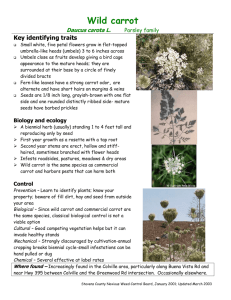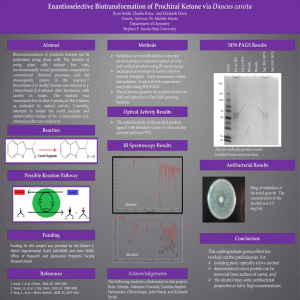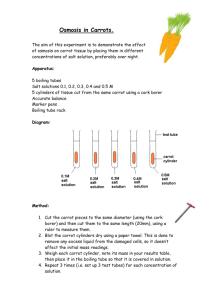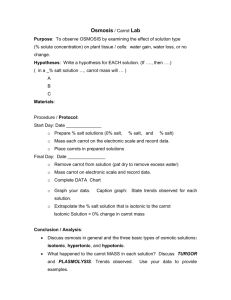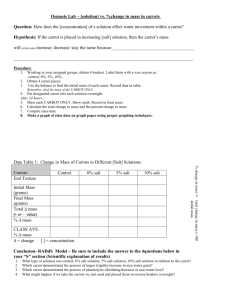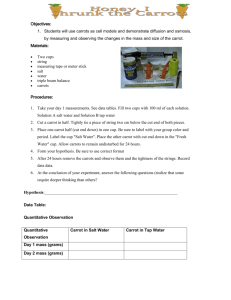Biotransformations: Reaction Conditions, Properties, and Enzyme Isolation Antimicrobial Jasmine Moreland
advertisement
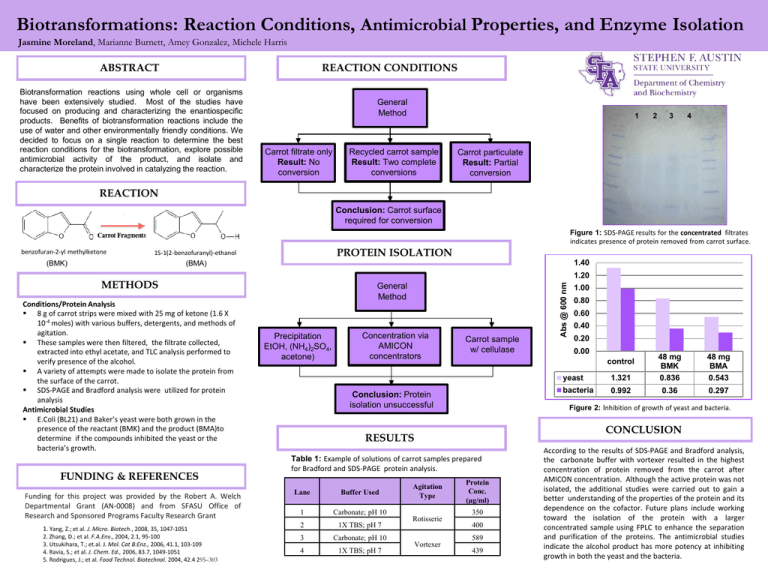
Biotransformations: Reaction Conditions, Antimicrobial Properties, and Enzyme Isolation Jasmine Moreland, Marianne Burnett, Amey Gonzalez, Michele Harris ABSTRACT REACTION CONDITIONS Biotransformation reactions using whole cell or organisms have been extensively studied. Most of the studies have focused on producing and characterizing the enantiospecific products. Benefits of biotransformation reactions include the use of water and other environmentally friendly conditions. We decided to focus on a single reaction to determine the best reaction conditions for the biotransformation, explore possible antimicrobial activity of the product, and isolate and characterize the protein involved in catalyzing the reaction. General Method Carrot filtrate only Result: No conversion 1 Recycled carrot sample Result: Two complete conversions 2 3 4 Carrot particulate Result: Partial conversion REACTION Conclusion: Carrot surface required for conversion Figure 1: SDS-PAGE results for the concentrated filtrates indicates presence of protein removed from carrot surface. benzofuran-2-yl methylketone PROTEIN ISOLATION 1S-1(2-benzofuranyl)-ethanol 1.40 (BMA) 1.20 METHODS Conditions/Protein Analysis 8 g of carrot strips were mixed with 25 mg of ketone (1.6 X 10-4 moles) with various buffers, detergents, and methods of agitation. These samples were then filtered, the filtrate collected, extracted into ethyl acetate, and TLC analysis performed to verify presence of the alcohol. A variety of attempts were made to isolate the protein from the surface of the carrot. SDS-PAGE and Bradford analysis were utilized for protein analysis Antimicrobial Studies E.Coli (BL21) and Baker’s yeast were both grown in the presence of the reactant (BMK) and the product (BMA)to determine if the compounds inhibited the yeast or the bacteria’s growth. FUNDING & REFERENCES Funding for this project was provided by the Robert A. Welch Departmental Grant (AN-0008) and from SFASU Office of Research and Sponsored Programs Faculty Research Grant 1. Yang, Z.; et al. J. Micro. Biotech., 2008, 35, 1047-1051 2. Zhang, D.; et al. F.A.Env., 2004, 2.1, 95-100 3. Utsukihara, T.; et.al. J. Mol. Cat B:Enz., 2006, 41.1, 103-109 4. Ravia, S.; et al. J. Chem. Ed., 2006, 83.7, 1049-1051 5. Rodrigues, J.; et al. Food Technol. Biotechnol. 2004, 42.4 295–303 General Method Precipitation EtOH, (NH4)2SO4, acetone) Concentration via AMICON concentrators Carrot sample w/ cellulase Carbonate; pH 10 2 1X TBS; pH 7 3 Carbonate; pH 10 4 1X TBS; pH 7 0.60 0.40 0.20 0.00 yeast 1.321 48 mg BMK 0.836 bacteria 0.992 0.36 48 mg BMA 0.543 0.297 CONCLUSION Table 1: Example of solutions of carrot samples prepared for Bradford and SDS-PAGE protein analysis. 1 0.80 Figure 2: Inhibition of growth of yeast and bacteria. RESULTS Buffer Used 1.00 control Conclusion: Protein isolation unsuccessful Lane Abs @ 600 nm (BMK) Agitation Type Rotisserie Vortexer Protein Conc. (µg/ml) 350 400 589 439 According to the results of SDS-PAGE and Bradford analysis, the carbonate buffer with vortexer resulted in the highest concentration of protein removed from the carrot after AMICON concentration. Although the active protein was not isolated, the additional studies were carried out to gain a better understanding of the properties of the protein and its dependence on the cofactor. Future plans include working toward the isolation of the protein with a larger concentrated sample using FPLC to enhance the separation and purification of the proteins. The antimicrobial studies indicate the alcohol product has more potency at inhibiting growth in both the yeast and the bacteria.
